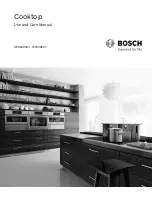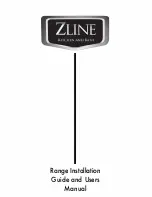
8
Causes of damage
NOTICES
▯
Scratches on glass ceramic surface:
Cookware with
rough bottoms will scratch the glass ceramic surface.
▯
Salt, sugar and sand:
Salt, sugar or grains of sand will
scratch the glass ceramic surface. Never use the
cooktop as a working surface or for setting things
down.
▯
Overheated cookware:
Avoid heating pots or pans
that are empty.
▯
Hot cookware:
Never set down hot pans and pots on
the control panel or frame. This may cause damage.
▯
Hard and sharp objects:
Hard or sharp objects falling
on the cooktop may damage it.
▯
Boiled-over food:
Sugar and products containing
sugar may damage the cooktop. Immediately eliminate
spills of these products with a glass scraper.
▯
Foils and plastics:
Aluminum foil and plastic will melt
on the hot cooking zones. Stove protective film isn't
suitable for your cooktop.
▯
Unsuitable cleaning agent:
Shimmering metallic
discolorations on the glass ceramic surface result from
the use of inappropriate cleaning agents and abrasion
from cookware.
Protecting the Environment
Energy-saving Advice
▯
Place a lid on cookware. Cooking with an uncovered
pan will result in a considerable increase in energy
use. Use a glass lid to provide visibility and avoid
having to lift the lid.
▯
Use cookware equipped with a solid, flat bottom.
Curved pan bases increase energy consumption.
▯
The diameter of the pan base must match the size of
the element. Note: The manufacturer normally
indicates the pan's upper diameter. This is normally
greater than the diameter of the pan's base.
▯
Choose cookware of a size suited to the amount of
food you are going to cook. A large pan that is only
half full will use a lot of energy.
▯
Use a small amount of water when cooking. This
saves energy, and vegetables retain a larger
percentage of their vitamins and minerals.
▯
Select the lowest power level to maintain cooking. If
the power level is too high, energy is wasted.
Cooking with Induction
Advantages of induction cooking
Induction cooking is very different from traditional
cooking methods, as heat builds up directly in the item of
cookware. This offers numerous advantages:
▯
Saves time when boiling and frying.
▯
Saves energy.
▯
Easier to care for and clean. Spilled food does not
burn on as quickly.
▯
Heat control and safety – the cooktop increases or
decreases the heat supply as soon as the user
changes the setting. The induction element stops the
heat supply as soon as the cookware is removed from
the element, without having to switch it off first.
Cookware
Only use ferromagnetic cookware for induction cooking,
such as:
▯
Cookware made from enameled steel
▯
Cookware made from cast iron
▯
Special induction-compatible cookware made from
stainless steel.
To check whether your cookware is suitable for induction
cooking, refer to the section on
.
To achieve a good cooking result, the ferromagnetic area
on the base of the pan should match the size of the
element. If an element does not detect an item of
cookware, try placing it on another element with a
smaller diameter.
FP
FP
FP
LQ
LQ
LQ
Summary of Contents for NIT8069SUC
Page 1: ...Use and Care Manual Cooktop NIT8069SUC NIT8069UC ...
Page 67: ......








































